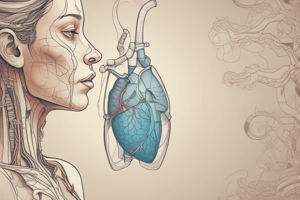Podcast
Questions and Answers
Wo erfolgt der Gasaustausch?
Wo erfolgt der Gasaustausch?
- In den Alveolen (correct)
- In den Bronchiolen
- In den Lungenvenen
- In den Lungenarterien
Was ist die maximale Menge an Luft, die nach maximaler Inhalation aus den Lungen ausgeatmet werden kann?
Was ist die maximale Menge an Luft, die nach maximaler Inhalation aus den Lungen ausgeatmet werden kann?
- Residualvolumen (RV)
- Vitale Kapazität (VC) (correct)
- Totale Lungenkapazität (TLC)
- Funktionelle Residualkapazität (FRC)
Welche beiden Formen dienen dem Sauerstofftransport im Blut?
Welche beiden Formen dienen dem Sauerstofftransport im Blut?
- Lösung in Plasma und Anbindung an Albumin
- Anbindung an Hämoglobin (Hb) und Lösung in Plasma (correct)
- Anbindung an Myoglobin (Mb) und Lösung in Plasma
- Anbindung an Hämoglobin (Hb) und Anbindung an Myoglobin (Mb)
Was passiert, wenn Sauerstoff aus dem HbO2 in die Gewebe freigesetzt wird?
Was passiert, wenn Sauerstoff aus dem HbO2 in die Gewebe freigesetzt wird?
Wo wird der Sauerstoff gespeichert, um später für die Muskeltätigkeit bereit zu sein?
Wo wird der Sauerstoff gespeichert, um später für die Muskeltätigkeit bereit zu sein?
Was bleibt in den Lungen zurück, nachdem die normale Exhalation abgeschlossen ist?
Was bleibt in den Lungen zurück, nachdem die normale Exhalation abgeschlossen ist?
Study Notes
Atemfunktion (Respiratory Function)
Gas Exchange
- Occurs in the alveoli, where oxygen (O2) diffuses into the blood and carbon dioxide (CO2) diffuses out
- Process involves:
- Oxygen diffusing from alveoli into pulmonary capillaries
- Binding to hemoglobin (Hb) in red blood cells
- Transport to body tissues
- Carbon dioxide diffusing from pulmonary capillaries into alveoli
- Exhalation out of the lungs
Lung Capacity
- Total Lung Capacity (TLC): total amount of air in the lungs at maximal inflation
- Vital Capacity (VC): maximum amount of air that can be exhaled after a maximal inhalation
- Functional Residual Capacity (FRC): amount of air remaining in the lungs after normal exhalation
- Residual Volume (RV): amount of air remaining in the lungs after maximal exhalation
Oxygen Transport
- Oxygen is transported in the blood in two forms:
- Bound to hemoglobin (Hb) in red blood cells
- Dissolved in plasma (minor amount)
- Hemoglobin (Hb) binds to oxygen in the lungs, forming oxyhemoglobin (HbO2)
- Oxygen is released from HbO2 to tissues, forming deoxyhemoglobin (Hb)
- Myoglobin (Mb) in muscle cells also stores oxygen for later use
Atemfunktion (Respiratory Function)
Gasaustausch
- Findet in den Alveolen statt, wo Sauerstoff (O2) in das Blut diffundiert und Kohlendioxid (CO2) heraus diffundiert
- Der Prozess beinhaltet:
- Diffusion von Sauerstoff aus den Alveolen in die pulmonalen Kapillaren
- Bindung an Hämoglobin (Hb) in roten Blutkörperchen
- Transport zu Körpergewebe
- Diffusion von Kohlendioxid aus den pulmonalen Kapillaren in die Alveolen
- Ausatmung aus den Lungen
Lungenkapazität
- Totale Lungenkapazität (TLC): Gesamtmenge an Luft in den Lungen bei maximaler Inflation
- Vitale Kapazität (VC): maximale Menge an Luft, die nach maximaler Inhalation ausgeatmet werden kann
- Funktionelle Restkapazität (FRC): Menge an Luft, die in den Lungen nach normaler Exhalation verbleibt
- Restvolumen (RV): Menge an Luft, die in den Lungen nach maximaler Exhalation verbleibt
Sauerstofftransport
- Sauerstoff wird im Blut in zwei Formen transportiert:
- An Hämoglobin (Hb) in roten Blutkörperchen gebunden
- In Plasma gelöst (geringe Menge)
- Hämoglobin (Hb) bindet Sauerstoff in den Lungen, bildet Oxyhämoglobin (HbO2)
- Sauerstoff wird aus HbO2 an Gewebe abgegeben und bildet Deoxyhämoglobin (Hb)
- Myoglobin (Mb) in Muskelzellen speichert Sauerstoff für späteren Gebrauch
Studying That Suits You
Use AI to generate personalized quizzes and flashcards to suit your learning preferences.
Description
Lerne die Prozesse des Gas-Austauschs in den Alveolen und die verschiedenen Kapazitäten der Lungen kennen. Entdecke, wie Sauerstoff und Kohlendioxid den Körper durch die Atmung erreichen und verlassen.




